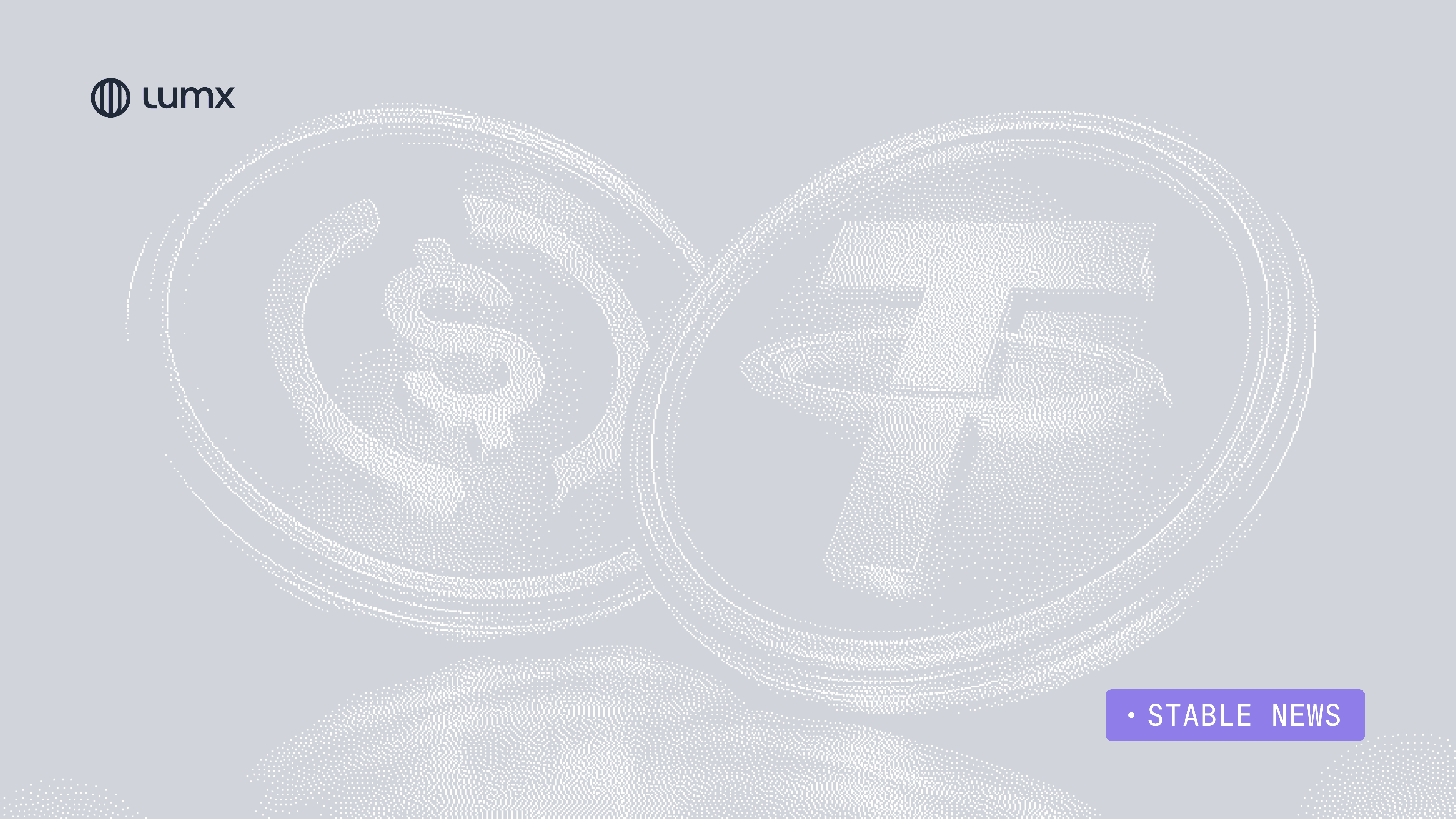Stable News is Lumx’s weekly curation of the most important developments in stablecoins, tokenization, and digital payments across the global economy.
This edition highlights PayPal’s PYUSD surpassing $1.3 billion and expanding to nine new blockchains, the Bank of Canada calling for federal stablecoin regulation, Plasma’s launch of its neobank Plasma One, Ripple turning RLUSD into an institutional off-ramp for BlackRock and VanEck funds, and a new report showing stablecoins already processing $2.3 trillion per month.
Reading time: 7 minutes
PayPal Expands PYUSD to Nine Blockchains, Reinforces Global Ambition
PayPal announced the expansion of its stablecoin PYUSD to nine new blockchains via integration with the LayerZero protocol, including Avalanche, Tron, and Aptos. Multichain circulation has also been integrated with Stargate, enabling cross-liquidity across more than 80 networks.
With this, PYUSD has reached $1.3 billion in market cap, consolidating its presence in the tokenized digital payments universe. This move adds to recent initiatives by the company, such as the launch of PayPal Links and its bid to issue Hyperliquid’s stablecoin.
PayPal is positioning itself not only as an issuer but as a central player in the next generation of digital financial infrastructure — expanding its role across both end-user adoption and the institutional backbone of the crypto-finance ecosystem.
Why it matters:
✅ PYUSD remains small in market share but is scaling fast through corporate distribution.
✅ PayPal combines its own stablecoin, mass-market app integration, and institutional presence.
✅ Demonstrates how fintechs can accelerate adoption through established channels.
Bank of Canada Calls for Federal Stablecoin Regulation
The Bank of Canada warned that the absence of federal regulation for stablecoins could compromise the country’s competitiveness. The report emphasized the high cost of international remittances — between 5% and 10% — compared to crypto alternatives that operate below 1%.
The study compares Canada with markets such as the U.S. and U.K., which have already advanced with specific frameworks, and recommends creating sandboxes and pilot projects to avoid reliance on foreign infrastructure.
The call aligns with a broader trend in Latin America, where countries like Brazil are advancing discussions on stablecoin and tokenized infrastructure regulation.
Why it matters:
✅ Remittances are one of the clearest and most socially relevant use cases for stablecoins.
✅ Lack of regulatory frameworks could hinder the competitiveness of Canadian fintechs.
✅ Reflects global pressure for clear, interoperable frameworks.
Plasma Launches Crypto-Native Neobank With Yield and Cashback
Plasma, a blockchain focused on stablecoins and transaction optimization, announced Plasma One, a neobank targeting retail users. The service promises 4% cashback, yields above 10% on stablecoins, and global coverage across 150 countries with physical and virtual cards.
This approach diverges from institutional players like Circle and Tether, betting instead on direct consumer distribution and user experience. The move highlights how the stablecoin field remains open to experimentation outside major conglomerates.
Why it matters:
✅ Underscores the role of crypto-native models in shaping payment infrastructure.
✅ Positions stablecoins as consumer products, not just technical infrastructure.
✅ Sparks debate on the long-term viability of high-yield offerings.
Ripple Connects BlackRock and VanEck Tokenized Funds to RLUSD
In partnership with Securitize, Ripple will allow investors in tokenized funds such as BlackRock’s BUIDL and VanEck’s VBILL to directly convert their shares into RLUSD, its native stablecoin.
The initiative strengthens Ripple’s role as a bridge between traditional financial assets and on-chain liquidity, positioning RLUSD as a relevant option for real-world asset (RWA) operations.
Why it matters:
✅ Reinforces stablecoins as a fundamental layer for institutional tokenization.
✅ Ripple expands its scope and directly challenges Circle’s USDC in the institutional segment.
✅ Highlights how major asset managers are already using stablecoins in structured financial products.
Stablecoins Process $2.3 Trillion Per Month: Money Movement 2.0 Report
The Money Movement 2.0 report, published by 51, shows that stablecoins process $2.3 trillion per month — a figure comparable to Visa. Total circulation has surpassed $280 billion, and 90% of global financial institutions are already actively exploring stablecoins.
Key highlights from the study include:
Circle’s 6x post-IPO valuation increase
Tether’s record $5 billion profit
Stripe’s acquisition of Bridge
Amazon and Walmart’s entry into proprietary stablecoins to cut payment fees
The report also points to convergence between stablecoins and AI as a catalyst for a new autonomous financial infrastructure layer.
Why it matters:
✅ Confirms stablecoins have reached scale and maturity comparable to major payment networks.
✅ Validates institutional and strategic adoption by global companies.
✅ Reframes stablecoins as a macroeconomic topic — beyond crypto.
Lumx Roundup

Last week, Lumx officially launched the new season of the Stable Talks podcast, powered by Bitso Business. The premiere episode features a conversation with Antonia, Visa LAC’s Head of Blockchain & Crypto, covering:
Visa’s role in stablecoin infrastructure
The evolution of collateralized cards
Regulatory dilemmas around CBDCs like Drex
Latin America’s role as an experimentation hub
The full episode is now available on YouTube and Spotify. Click here to explore past episodes and more details about Stable Talks.
This Thursday, the second episode drops, featuring Amit Cheela, U.S. CEO at BVNK, discussing the challenges of card programs and the future of stablecoin integration with traditional payment systems. Click here to watch a preview.
With PayPal scaling its multichain presence, Ripple linking traditional assets to crypto liquidity, and initiatives like Plasma exploring alternative distribution models, it’s clear that stablecoins are becoming more deeply embedded in global finance.
Regulation is catching up. Data confirms the scale. And the variety of models, institutional, native, corporate, shows the financial infrastructure of the future will inevitably be tokenized.
See you in the next edition.





